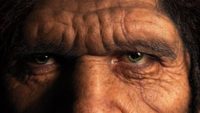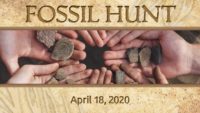By Dr. Georgia Purdom Justin is an itinerant preacher and founder of Justin Peters Ministries. Here’s what he had to share about his upcoming presentation at Answers for Women 2020. …read more Source: AIG Daily
By Dr. David Menton As far as stereotypes go, cavemen make easy targets—especially when transplanted into the twenty-first century. …read more Source: AIG Daily
By Dr. Andrew Fabich With all the press on Coronavirus, it seemed appropriate to include a preliminary response. Truett McConnell University allowed us to reprint a recent blog. …read more Source: AIG Daily
By Ken Ham How do we know who God is? Well, there are a lot of false ideas in our culture about who God is. It’s very popular to believe God is this fuzzy, nebulous idea of love; he expects nothing of you, but he’s there if you’re in trouble. Or what about the idea that God is all judgment—ready to strike down anyone who doesn’t get everything “just right.” And then there’s the popular belief that God is in everything or that we can just base who God is to us on our experiences. Which view is right? Our [More]
Can biological pigment molecules really survive over a billion years? …read more Source: creation.com
Why do we have solar wind? Startling discoveries by Voyager 2 show its great benefits to life. …read more Source: creation.com
Loved or loathed, rabbits certainly fit the biblical narrative, not an evolutionary one. …read more Source: creation.com
The Gospel removes the guilt and shame of our sin, and gives us the right to sit with Christ on His throne. …read more Source: creation.com
By Ken Ham A recent popular science article announced that “genes that have evolved from scratch are both more common and more important than previously believed.” These so-called “orphan genes . . . appear to have no relatives and are often responsible for unique characteristics and abilities of organisms.” Of course, evolutionists attribute the existence of such genes to naturalistic evolution. But did brand-new genetic information really evolve? Dr. Nathaniel Jeanson, who earned his PhD in cell and developmental biology from Harvard University, shared this with me about these two new studies: In these studies, evolutionists continued their quest to [More]
Wooly mammoths once roamed North America, northern Europe, and Siberia. Possibly the last of their kind perished as a dwindling population on Wrangel Island, northeast of Siberia. Who wouldn’t wonder why wooly mammoths no longer roam our planet? The process of gathering clues to their extinction can evoke the same feelings found in good mystery novels. New research into ancient DNA gives another solid clue toward two old culprit theor… More… …read more Source: icr.org
Former Bishop of Edinburgh The Right Reverend Richard Holloway blames Genesis for the world’s environmental problems and tells the Author of Genesis he has been badly misunderstood! …read more Source: creation.com
Homo erectus and modern human origins …read more Source: creation.com
By Sarah Chaffee On this episode of ID the Future we hear John Mark Reynolds’ concluding comments at the November 2019 symposium in honor of the late Phillip E. Johnson. Reynolds is a Fellow with the Discovery Institute’s Center for Science and Culture, president of the Constantine School in Houston, and a long-time friend of Phillip Johnson. Reynolds says he saw in Johnson a mind constant and relentless in the pursuit of truth, a man who refused to distort the truth to fit it into a materialist paradigm, and who passed along that mindset to as many as he could, [More]
By Ken Ham How often do you have an opportunity to Young people will never forget meeting and chatting with such qualified and experienced creation scientists. It’s a phenomenal experience for all. Thanks for stopping by and thanks for praying,Ken This item was written with the assistance of AiG’s research team. …read more Source: Ken Ham AIG
By Ann Gauger On this episode of ID the Future, we hear biologist and Center for Science and Culture senior fellow Ann Gauger speaking at a gathering to honor the recently deceased Dr. Phillip Johnson, the Berkeley law professor known affectionately as the “godfather” of the intelligent design movement. Dr. Gauger tells of her journey of discovery, how she returned to a science career three times in her life, how she found her way into the ID movement, and how Johnson emboldened her to give free rein to a healthy scientific skepticism, one that has long had her pushing back [More]
Many students are told about how increasing coal soot during Britain’s 18th and 19th century industrial revolution drove the color change observed in black peppered moths. The famous peppered moth story is one of the most persuasive evidences cited in textbooks in support of evolution. But recent genetic findings are raising questions about the accuracy of the scenario told by evolutionists. Students are taught that o… More… …read more Source: icr.org
By Dr. Gordon Wilson Despite their bad reputation, cockroaches were designed to do good things. …read more Source: AIG Daily
By Ken Ham How do we know who God is? Well, there are a lot of false ideas in our culture about who God is. It’s very popular to believe God is this fuzzy, nebulous idea of love; he expects nothing of you, but he’s there if you’re in trouble. Or what about the idea that God is all judgment—ready to strike down anyone who doesn’t get everything “just right.” And then there’s the popular belief that God is in everything or that we can just base who God is to us on our experiences. Which view is right? Children [More]
Carnivorous dinosaurs pre-Flood: Wouldn’t lots of apex predators be problematic for the biblical creation perspective? …read more Source: creation.com
By Ken Ham The latest issue of the award-winning In this issue you’ll also learn about: A puzzle of mud and bones Cockroaches (yes, God’s handiwork is seen even in these bugs with a bad reputation!) Trichoplax adhaerens (you’ll have to subscribe to the magazine to find out what that even is!) Why innocent children suffer And much more! Answers magazine is packed with articles and features that will encourage you in your faith, point you towards our amazing Creator, and strengthen your worldview. There’s even a mini-magazine included for kids (this issue features the death and resurrection of Jesus [More]
By Paul Nelson On this episode of ID the Future, philosopher of biology Paul Nelson wraps discussion of his recent visit to the Galapagos Islands, sharing lessons he learned there. He says Darwin was right to see natural history as crucial to understanding biology; but he was wrong in making it the be-all and end-all. Nelson then limns a picture of a day when scientists frankly concede the limits of evolution and the necessity of intelligent design in the history of life, and with the ID/evolution war behind them, can explore without distraction the fertile ground of integrating the aspects [More]
By Paul Nelson On this episode of ID the Future, philosopher of biology Paul Nelson continues his discussion with host Andrew McDiarmid about Nelson’s recent visit to the Galapagos Islands, made famous by Charles Darwin. Nelson explains how Darwin was right — partly. Darwin urged biologists to consider the history of a plant or animal, an idea that was much neglected in the work of his predecessors. As Darwin’s experience on the Galapagos showed, and as Nelson’s experience there echoed, history must be part of our explanation for how species and populations have become the way they are today. At [More]
By Dr. Georgia Purdom Many times we get so caught up in learning about the lies that we forget to study the best weapon to combat them?God’s Word! …read more Source: AIG Daily
In reality, only a small sampling of climate scientists believes we are facing imminent doom. So why all the insistence on anxiety and panic? …read more Source: AIG Daily
A new model that claims Adam and Eve can be the genealogical ancestors, but not the genetic ancestors, of all people alive today, after people evolved from apes, fails all biblical tests. …read more Source: creation.com
The Ark Encounter has been chosen as the best religious museum in the United States, out of 20 nominees, and the Creation Museum finished second! …read more Source: AIG Daily
By Sarah Chaffee On this episode of ID the Future, host Rob Crowther talks with Discovery Institute Senior Fellow and philosopher of science Paul Nelson about the upcoming Summer Seminars at the Discovery Institute in Seattle in July. In two overlapping tracks, these seminars provide nine days of intensive study on design in the natural sciences and in humanities and the social sciences, with the opportunity to interact with top scholars and other students. It’s “summer camp for nerds,” says Nelson, and the opportunity for upper-level undergrads, grad students, professors, and professionals to break free of the isolation they often [More]





































